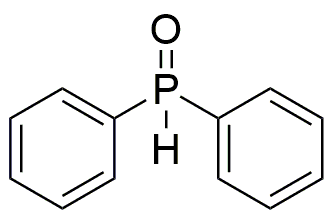Diphenylphosphine oxide is widely utilized in research focused on:
- Synthesis of Organophosphorus Compounds: This chemical serves as a key intermediate in the production of various organophosphorus compounds, which are important in agriculture as pesticides and herbicides.
- Ligand in Coordination Chemistry: It acts as a versatile ligand in coordination chemistry, enhancing the stability and reactivity of metal complexes used in catalysis and materials science.
- Pharmaceutical Development: In medicinal chemistry, it is used to develop new drugs, particularly those targeting neurological disorders, due to its ability to modify biological activity.
- Flame Retardants: The compound is incorporated into polymers to improve their fire resistance, making it valuable in the production of safer materials for construction and textiles.
- Analytical Chemistry: It is employed in analytical methods to detect and quantify phosphine derivatives, aiding in environmental monitoring and quality control in various industries.
General Information
Properties
Safety and Regulations
Applications
Diphenylphosphine oxide is widely utilized in research focused on:
- Synthesis of Organophosphorus Compounds: This chemical serves as a key intermediate in the production of various organophosphorus compounds, which are important in agriculture as pesticides and herbicides.
- Ligand in Coordination Chemistry: It acts as a versatile ligand in coordination chemistry, enhancing the stability and reactivity of metal complexes used in catalysis and materials science.
- Pharmaceutical Development: In medicinal chemistry, it is used to develop new drugs, particularly those targeting neurological disorders, due to its ability to modify biological activity.
- Flame Retardants: The compound is incorporated into polymers to improve their fire resistance, making it valuable in the production of safer materials for construction and textiles.
- Analytical Chemistry: It is employed in analytical methods to detect and quantify phosphine derivatives, aiding in environmental monitoring and quality control in various industries.
Documents
Safety Data Sheets (SDS)
The SDS provides comprehensive safety information on handling, storage, and disposal of the product.
Product Specification (PS)
The PS provides a comprehensive breakdown of the product’s properties, including chemical composition, physical state, purity, and storage requirements. It also details acceptable quality ranges and the product's intended applications.
Certificates of Analysis (COA)
Search for Certificates of Analysis (COA) by entering the products Lot Number. Lot and Batch Numbers can be found on a product’s label following the words ‘Lot’ or ‘Batch’.
*Catalog Number
*Lot Number
Certificates Of Origin (COO)
This COO confirms the country where the product was manufactured, and also details the materials and components used in it and whether it is derived from natural, synthetic, or other specific sources. This certificate may be required for customs, trade, and regulatory compliance.
*Catalog Number
*Lot Number
Safety Data Sheets (SDS)
The SDS provides comprehensive safety information on handling, storage, and disposal of the product.
DownloadProduct Specification (PS)
The PS provides a comprehensive breakdown of the product’s properties, including chemical composition, physical state, purity, and storage requirements. It also details acceptable quality ranges and the product's intended applications.
DownloadCertificates of Analysis (COA)
Search for Certificates of Analysis (COA) by entering the products Lot Number. Lot and Batch Numbers can be found on a product’s label following the words ‘Lot’ or ‘Batch’.
*Catalog Number
*Lot Number
Certificates Of Origin (COO)
This COO confirms the country where the product was manufactured, and also details the materials and components used in it and whether it is derived from natural, synthetic, or other specific sources. This certificate may be required for customs, trade, and regulatory compliance.


